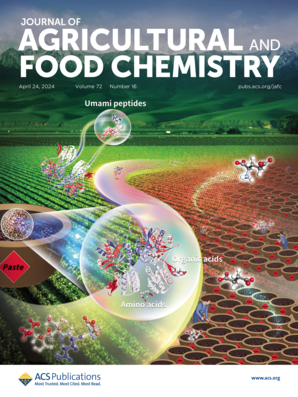工程醇脱氢酶高效催化合成(R)-4-氯-3-羟基丁酸乙酯
IF 5.7
1区 农林科学
Q1 AGRICULTURE, MULTIDISCIPLINARY
引用次数: 0
摘要
乙基(R)-4-氯-3-羟基丁酸酯[(R) -CHBE]是一种具有很高医药和农药应用价值的中间体。醇脱氢酶在(R) -CHBE合成过程中是一种很好的生物催化剂。然而,缺乏有效的工程方法限制了其广泛应用。本研究采用序列建模-对接原理(SMDP)方法筛选具有催化活性的酶。为提高醇脱氢酶LCRIII的催化效率,建立了活性中心、底物通道和远端热点3种蛋白修饰策略。底物批量补充可以减轻底物的抑制作用。随后,成功获得最佳突变体M3 (W151F-S167A-F215Y),比酶活性为23.00 U/mg, kcat/Km为11.22 (mM-1·min-1),分别比野生型高4.55倍和3.98倍。(R) -CHBE以M3和GDH为原料,浓度为298.21 g/L (99% e.e)。该研究为乙醇脱氢酶的蛋白质工程修饰和(R) -CHBE的工业化生产提供了一条有前景的途径。本文章由计算机程序翻译,如有差异,请以英文原文为准。

Engineering Alcohol Dehydrogenase for Efficient Catalytic Synthesis of Ethyl (R)-4-Chloro-3-hydroxybutyrate
Ethyl (R)-4-chloro-3-hydroxybutyrate [(R)–CHBE] is an intermediate with high value in medicine and pesticide applications. Alcohol dehydrogenase serves as an excellent biocatalyst during the synthesis of (R)–CHBE. However, the lack of effective engineering methods limits its wider application. In this study, the sequence-modeling-docking-principle (SMDP) method was used to screen enzymes with catalytic activity. Three protein modification strategies were established for the active center, substrate channel, and distal hotspot to enhance the catalytic efficiency of alcohol dehydrogenase LCRIII. Substrate batch replenishment was used to alleviate substrate inhibition. Subsequently, optimal mutant M3 (W151F–S167A-F215Y) was successfully obtained with a specific enzyme activity of 23.00 U/mg and kcat/Km of 11.22 (mM–1·min–1), which were 4.55- and 3.98-fold higher than those of the wild type, respectively. (R)–CHBE was prepared using M3 and GDH at 298.21 g/L (>99% e.e.). This study provides a promising approach for the protein engineering modification of alcohol dehydrogenase and industrial-scale production of (R)–CHBE.
求助全文
通过发布文献求助,成功后即可免费获取论文全文。
去求助
来源期刊
CiteScore
9.90
自引率
8.20%
发文量
1375
审稿时长
2.3 months
期刊介绍:
The Journal of Agricultural and Food Chemistry publishes high-quality, cutting edge original research representing complete studies and research advances dealing with the chemistry and biochemistry of agriculture and food. The Journal also encourages papers with chemistry and/or biochemistry as a major component combined with biological/sensory/nutritional/toxicological evaluation related to agriculture and/or food.

 求助内容:
求助内容: 应助结果提醒方式:
应助结果提醒方式:


